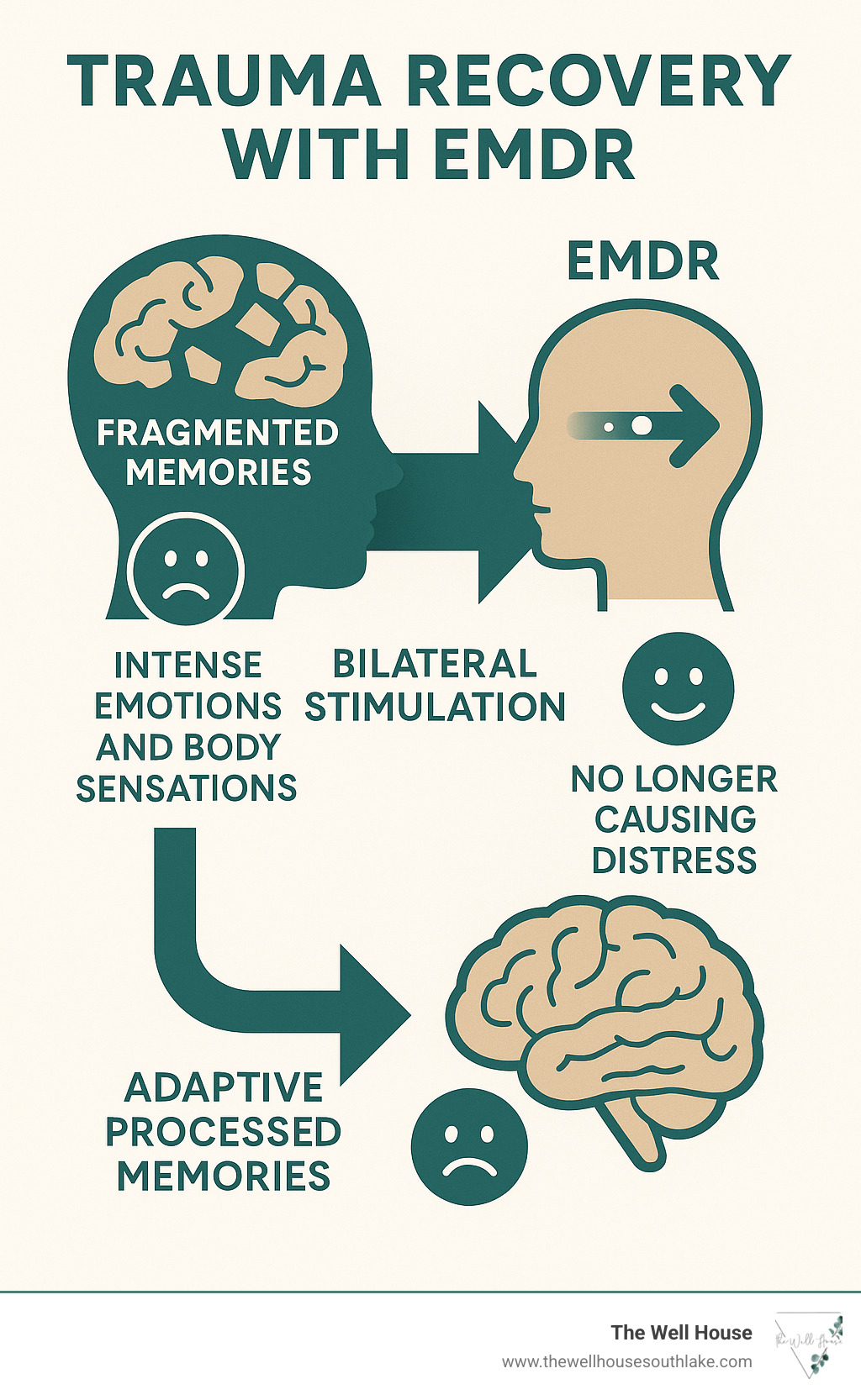Beyond the Pain: EMDR’s Path to Lasting Trauma Recovery
Why Trauma Recovery EMDR Offers Hope When You Feel Stuck
Trauma recovery emdr is a proven psychotherapy using bilateral stimulation (like eye movements) to help the brain naturally process traumatic memories. Here’s what you need to know:
Key Benefits:
- 84-90% effective for single-trauma victims in just 3 sessions
- No detailed talking about your trauma required
- Faster results than traditional talk therapy
- Lasting changes in how you view yourself and your experiences
How It Works:
- Uses eye movements or other bilateral stimulation
- Helps “unstick” frozen traumatic memories
- Allows your brain to process experiences naturally
- Transforms painful memories into sources of strength
If you’re carrying the weight of trauma from past experiences, you’re not alone. Many mothers feel disconnected, anxious, or like they’re just surviving. The good news is that trauma doesn’t have to define your story.
Eye Movement Desensitization and Reprocessing (EMDR) therapy offers a path forward that doesn’t require reliving every painful detail. Instead of endless talking, EMDR helps your brain process these experiences so they lose their power over you.
As one trauma survivor shared: “I survived it and I am strong” – a powerful shift from the horror and self-blame that once consumed her thoughts.
I’m Jennifer Kruse, a Licensed Professional Counselor Supervisor who specializes in helping women steer their healing journeys through soul-mind-body integration. Through my work with trauma recovery emdr and holistic approaches, I’ve witnessed countless mothers refind their strength, peace, and authentic selves after trauma.

Learn more about trauma recovery emdr:
Understanding EMDR: A New Path to Healing
In 1987, Dr. Francine Shapiro noticed her own disturbing thoughts lessened when her eyes moved back and forth. This simple observation led her to scientifically study the phenomenon, which would revolutionize trauma treatment.
Trauma recovery emdr – Eye Movement Desensitization and Reprocessing – emerged from that walk. Since Dr. Shapiro published her findings in 1989, EMDR has helped millions heal from disturbing life experiences.
Unlike traditional talk therapy, EMDR doesn’t require you to discuss every painful detail. Instead, it uses bilateral stimulation – guided eye movements, sounds, or gentle taps – to help your brain process traumatic memories naturally. It’s like giving your brain’s natural healing system a gentle nudge.
You can learn more about this integrative psychotherapy approach at the EMDR Foundation.
The Science Behind Healing: The Adaptive Information Processing (AIP) Model
Your brain has a natural healing system for emotional wounds, explained by the Adaptive Information Processing (AIP) model. This model shows how the system works—and what happens when trauma gets in the way.
When you experience something traumatic, your brain’s processing system can get overwhelmed. The memory gets stuck—frozen in time with all the raw emotions, physical sensations, and disturbing thoughts attached.
These unprocessed memories remain painful and raw. Triggers like a familiar smell or sound can activate them, making you feel like you’re reliving the trauma because your brain doesn’t realize the danger has passed.
This is where trauma recovery emdr steps in. Through structured sessions with bilateral stimulation, EMDR helps “unstick” these frozen memories, allowing your brain to access and process them in a new way.
The insights and healing come from your own accelerated processing, not from a therapist’s interpretation. As memories are processed, emotional distress fades, negative beliefs transform, and your body’s stress response calms down.
Want to dive deeper? Check out our detailed explanation on how EMDR therapy works.
How EMDR Differs from Traditional Trauma Therapies
EMDR feels refreshingly different from traditional therapy.
Less talking, more processing. You won’t need to describe your trauma in exhausting detail. EMDR focuses on your internal experience—images, sensations, and thoughts—while using bilateral stimulation. This often feels less overwhelming than talk therapy.
No homework assignments. While we teach self-calming techniques, EMDR doesn’t typically involve detailed homework. The real work happens in the therapy room.
Changing how memories are stored. EMDR changes how traumatic memories are stored in your brain, reducing their emotional charge so they feel more like regular memories.
Faster results for many people. Research shows impressive outcomes: 84-90% of single-trauma victims no longer meet PTSD criteria after just three 90-minute sessions. A Kaiser Permanente study found that 100% of single-trauma victims and 77% of combat veterans were free from PTSD after only six sessions.
Everyone’s healing journey is unique, but for many, EMDR offers a more direct path to processing trauma with less emotional distress during sessions.
Your Journey Through the 8 Phases of EMDR Therapy
When you begin trauma recovery emdr, you start a structured, eight-phase journey. It’s not a random walk through your memories but a refined approach designed for your safety and success.
You and your therapist work as a team, with safety and trust as the foundation. Each phase builds on the last, creating a solid framework for healing.
The 8 Phases of EMDR therapy are:
- Phase 1: History-Taking and Treatment Planning
- Phase 2: Preparation
- Phase 3: Assessment
- Phase 4: Desensitization
- Phase 5: Installation
- Phase 6: Body Scan
- Phase 7: Closure
- Phase 8: Re-evaluation
Phase 1 & 2: History-Taking and Preparation
Your trauma recovery emdr journey begins with us getting to know your unique story and building the tools you’ll need for healing, without rushing into painful memories.
Phase 1: History-Taking and Treatment Planning involves exploring your history to identify disturbing events and current triggers. This helps us create a personalized roadmap for your healing.
Phase 2: Preparation focuses on building a strong, trusting relationship and explaining how EMDR works. Most importantly, we help you develop coping skills, like the “Safe/Calm Place” exercise—a mental sanctuary for grounding. These techniques give you control over your emotional experience.
At The Well House, we often weave in mindfulness practices. Learn more about how we blend these approaches on our EMDR and Mindfulness page.
Phase 3-6: Assessment, Desensitization, and Installation
These four phases are the heart of your healing journey, where stuck memories finally get unstuck.
Phase 3: Assessment maps the target memory. We identify the most vivid mental image, the Negative Cognition (e.g., “I am helpless”), and the Positive Cognition you’d rather believe (e.g., “I am strong”). We use the SUD scale (0-10) to measure distress and the VOC scale (1-7) to track how true the positive belief feels.
Phase 4: Desensitization is where the processing begins. While you hold the memory in mind, we start bilateral stimulation. You simply notice what comes up—thoughts, feelings, or sensations—without judgment. The goal is to bring the SUD level down to zero.
Phase 5: Installation strengthens the positive belief. We use bilateral stimulation to help your brain absorb the truth—that you are strong and safe—until it feels completely true (a VOC of 7).
Phase 6: Body Scan is a final check-in. We do a mental scan from head to toe, addressing any remaining tension connected to the memory with more bilateral stimulation to ensure healing is complete.
Phase 7 & 8: Closure and Re-evaluation
The final phases of trauma recovery emdr ensure your healing sticks.
Phase 7: Closure ensures you leave each session feeling stable. If a memory isn’t fully processed, we use containment techniques so you never leave feeling worse. We’ll teach you self-calming techniques and encourage journaling to capture insights between sessions.
Phase 8: Re-evaluation happens at the start of each new session. We check on previously processed memories to ensure they’re still resolved. This phase also helps us identify new targets or create future templates—mental rehearsals for responding to future challenges with your newfound strength.
The Power of Trauma Recovery EMDR: Conditions and Effectiveness
While known for treating PTSD, the healing power of trauma recovery emdr extends to many other mental health challenges. It helps the brain reprocess disturbing experiences, creating meaningful change.
PTSD remains the condition EMDR is best known for treating, but the healing doesn’t stop there. Anxiety disorders, including panic attacks and phobias, often respond beautifully as EMDR reprocesses the underlying memories fueling the fear.
Depression and grief can also be addressed, as EMDR helps shift unresolved past events and negative self-beliefs. It can also be effective for eating disorders, addictions, performance anxiety, chronic pain, and healing from sexual or physical abuse by targeting the traumatic roots of these struggles.
At The Well House, we offer comprehensive Counseling for Trauma and specialize in EMDR for Complex Trauma, recognizing that each healing journey is unique.
The Evidence Speaks: Research and Success Rates
The scientific support for trauma recovery emdr is overwhelming. Leading health organizations, including the World Health Organization (2013), the American Psychiatric Association, and the U.S. Department of Veterans Affairs, recognize it as a highly effective, best-practice treatment for trauma.
Success rates are remarkable: 84-90% of single-trauma victims no longer have PTSD after just three 90-minute sessions. A Kaiser Permanente study found 100% of single-trauma victims and 77% of multiple trauma victims were free of their PTSD diagnosis after only six 50-minute sessions. Even 77% of combat veterans became free of PTSD in just 12 sessions. These numbers represent real, lasting change.
Benefits and Potential Risks of EMDR
Choosing trauma recovery emdr opens doors to profound healing, but it’s important to understand both its benefits and potential risks.
The rapid results often surprise people, with many finding significant relief in just a few sessions. This efficiency means less time in distress and a faster return to feeling like yourself.
EMDR is often less overwhelming than traditional therapies because it doesn’t require you to describe your trauma in painful detail. The lasting changes happen at a neurological level, leading to a feeling of empowerment as you move from victim to survivor.
During treatment, it’s normal to be aware of a few things. You might experience a temporary increase in distress, vivid dreams, or the surfacing of unexpected emotions or memories as your brain processes the material. You may also feel mentally tired after sessions, similar to post-workout fatigue.
A qualified Certified EMDR Therapist is key to navigating this process safely. They will prepare you with coping skills and guide you through each phase, prioritizing your well-being every step of the way.
Finding Support: Resources for Patients and Professionals
When you’re ready to explore trauma recovery emdr, a network of support is waiting. Professional organizations like the EMDR International Association (EMDRIA) and the EMDR Research Foundation set the gold standard for practice and provide valuable resources.
These organizations also support community resilience. EMDR therapists often volunteer to help communities heal after disasters, providing pro bono services to first responders and others affected by trauma.
For Individuals Seeking Trauma Recovery EMDR
Finding the right therapist for trauma recovery emdr is crucial. Your best starting point is the EMDRIA directory. The Find an EMDR Therapist via EMDRIA website lists therapists who have completed approved training programs.
Look for certification when possible. A Certified EMDR Therapist has completed additional consultation hours and gained more experience, demonstrating a higher level of expertise.
Most therapists offer a brief consultation call. This is your chance to ask about their experience and get a feel for their approach. Trust your instincts—feeling comfortable and safe with your therapist is essential for this deep emotional work.
Helpful questions to ask include their experience with your particular concerns and what you can expect from the process. A phone call can give you a better sense of their communication style.
The EMDR Research Foundation also offers valuable public information at Information for the Public from the EMDR Foundation.
For Clinicians: EMDR Training and Certification
For mental health professionals adding trauma recovery emdr to their practice, proper, EMDRIA-approved training is essential. The EMDR Institute, founded by Dr. Francine Shapiro, is a premier source for training that preserves her original protocols.
Basic training provides the foundation, covering theory, the eight phases, and supervised practice. Advanced training opportunities are available for those who want to deepen their expertise in areas like complex trauma or working with children.
Becoming a Certified EMDR Therapist requires completing basic training, accumulating significant client hours, and receiving extensive consultation. This rigorous process demonstrates a commitment to excellence for both you and your clients.
Frequently Asked Questions about Trauma Recovery EMDR
When first learning about trauma recovery emdr, it’s natural to have questions. Here are answers to the most common ones to help you feel more informed.
How long does EMDR therapy take?
The timeline for trauma recovery emdr varies, as we work at your unique pace. Sessions typically run 50 to 90 minutes.
For a single traumatic event, many clients find significant relief after just three to six sessions. For those with multiple or complex traumas, the journey may take longer, typically eight to twelve sessions or more.
Remember: speed isn’t the goal, healing is. Your brain knows how to heal; we’re just providing the right conditions for that natural process to unfold.
Do I have to talk about my trauma in detail?
With trauma recovery emdr, you typically don’t need to describe your trauma in extensive detail. This is a key difference from traditional talk therapy.
Instead of verbal storytelling, the focus is on your internal experience. You’ll think about the disturbing memory while engaging in bilateral stimulation, and the processing happens inside your mind. You simply notice what comes up—images, sensations, or feelings.
This approach is often much less re-traumatizing and feels safer for many clients, as you’re not stuck in the painful narrative. You are always in control of what you share.
Is EMDR therapy done online?
Yes, absolutely! Trauma recovery emdr adapts beautifully to online sessions, and we have successfully provided virtual EMDR for years.
Online EMDR allows you to receive this powerful therapy from home, eliminating concerns about childcare or travel. For many busy mothers, this flexibility is life-changing.
Bilateral stimulation is adapted for online use, with visual cues on your screen, audio tones, or self-tapping techniques. The core healing process remains just as effective.
All you need is a stable internet connection and a private, quiet space. We use secure, HIPAA-compliant platforms to protect your privacy.
Our team at The Well House has extensive experience with virtual therapy, offering the same high-quality care as in-person sessions. We’re proud to offer comprehensive Southlake Counseling Services that include telehealth options for clients throughout Texas.
Insurance & Payment Options at The Well House Southlake
At The Well House Southlake, we believe that quality mental health care should be both accessible and affordable. Whether you’re seeking therapy, couples counseling, or online sessions, our goal is to make it easy for you to access therapy that takes insurance and supports your unique needs.
We currently accept:
- Blue Cross Blue Shield (BCBS)
- Aetna
- United Health care (UHC)
- Self-Pay and Out-of-Network Options
If you’re exploring counseling that takes insurance or need help verifying your coverage, our team will guide you through each step — from confirming your benefits to booking your first session. We’re committed to making your experience simple and stress-free, so you can focus on what matters most: your well-being.
Conclusion: Take the First Step Towards Healing
If you’re reading this, part of you is ready for change. That’s the courage that will carry you through your healing journey.
Living with unprocessed trauma is like carrying an invisible weight. You’re not broken; your brain is simply holding onto experiences that need proper processing to heal.
Trauma recovery emdr offers a different path that doesn’t require you to relive every painful detail. It works with your brain’s natural healing capacity to help “stuck” memories find their proper place. Research shows most people find significant relief in just a few sessions.
At The Well House, we understand that taking the first step can feel scary. Our approach is built on collaboration and genuine care for your whole person—mind, body, and spirit. We meet you where you are, whether in our Southlake office or through secure telehealth sessions.
You deserve to feel like yourself again, to wake up without that heavy feeling, and to have relationships not shadowed by past pain. Lasting recovery is possible, and you don’t have to walk this path alone.
Your healing journey is waiting. We’d be honored to walk alongside you as you reclaim your strength, peace, and authentic self.









